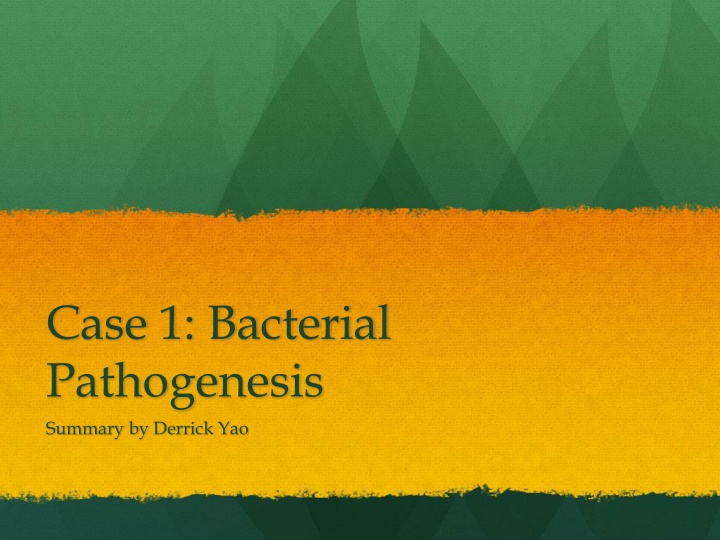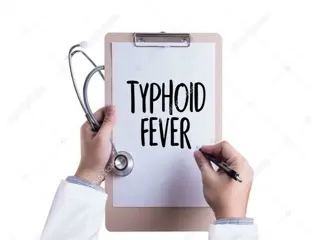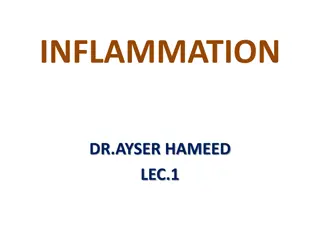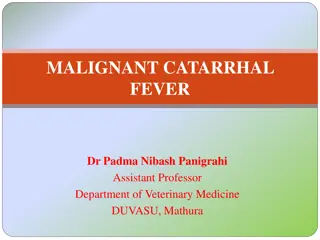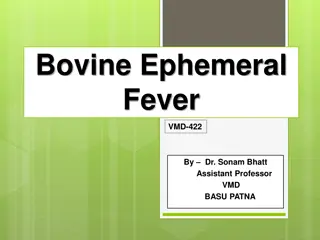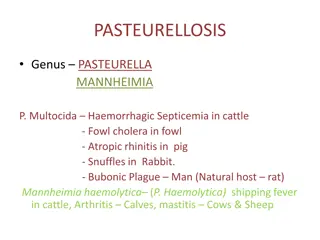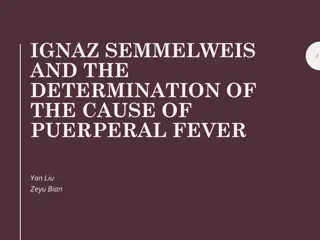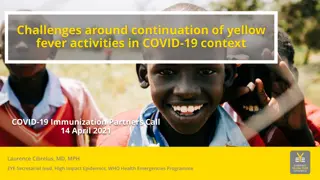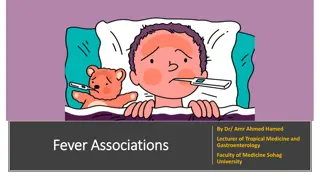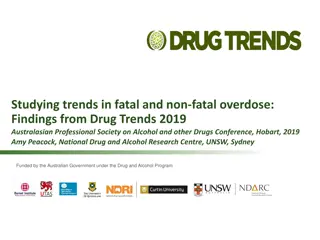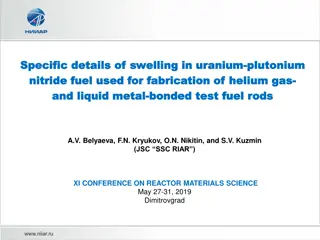Acute Fatal Disease: High Fever and Swelling in Livestock
Highly fatal disease HS in livestock characterized by acute septicaemia, high fever, and swellings causing dyspnoea. It affects various animals and can be transmitted through ingestion or inhalation. Clinical findings include high fever, salivation, petechiae, and painful swellings. Treatment involves administering various antibiotics early, along with supportive therapy. Prevention is by vaccination with different types of vaccines recommended at specific ages. Effective prevention and control measures are crucial for managing this disease.
Download Presentation

Please find below an Image/Link to download the presentation.
The content on the website is provided AS IS for your information and personal use only. It may not be sold, licensed, or shared on other websites without obtaining consent from the author.If you encounter any issues during the download, it is possible that the publisher has removed the file from their server.
You are allowed to download the files provided on this website for personal or commercial use, subject to the condition that they are used lawfully. All files are the property of their respective owners.
The content on the website is provided AS IS for your information and personal use only. It may not be sold, licensed, or shared on other websites without obtaining consent from the author.
E N D
Presentation Transcript
Case 1: Bacterial Pathogenesis Summary by Derrick Yao
Bacterial Encounter Stephanie has shown signs of Impetigo based on her symptoms such as red sores around her mouth and nose The disease, Impetigo, can be caused by: S. aureus S. pyogenes
Bacterial Encounter Location of S. aureus: Geographically, present in temperate and usually affluent regions such as N. America Host wise, reside under the skin and anterior nares of the nasopharynx, throat and hair Survival of S. aureus in host: Optimal temp. for growth at 37 C degrees which is the human body temperature and optimal pH ~7 which is around pH of mucosa and skin Ability to resist phagocytosis by biolfilm formation, capsule, protein A, surface proteins and modification to cell surface Ability to survive in phagosome due to cell wall s resistance to lysozyme
Bacterial Encounter Location of S. pyogenes: Geographically can be found in temperate regions with a greater burden of disease Host wise, present in epithelial surfaces like the nasopharyngeal mucosa (throat) and skin Survival of S. pyogenes in host: Surface- associated M protein, Mac protein and hyaluronic acid capsule to resist/inhibit phagocytosis Able to resist intracellular killing by PMNs and survive intracellularly within phagocytic cells http://medical-dictionary.thefreedictionary.com/phagocytosis
Bacterial Encounter How did Stephanie encounter S. pyogenes and S. aureus? Scratched skin around her mouth and nose which weakens the skin and exposing the region to bacteria Could have gotten a cut in school which breaks the epithelial barrier Coughing and sneezing via respiratory droplets Skin-to-skin contact, food or an environmental factor harboring the bacteria Could be part of her microbiota
Bacterial Entry S. aureus: Enter through broken skin and reside in the localized tissue of the entry site; can also enter through respiratory tract Once colonization is established, S. aureus positions itself near throat, ear, mouth and sinus Uses fibronectin, fibrinogen-binding proteins (FnbP) and surface collagen receptors to attach to damaged tissues exposing collagen-rich dermis Uses membrane-damaging toxins, clumping factors (B) and staphylokinase to promote adherence to host Alpha toxin binds to host cell membrane and form pores in human cells such as red blood cells Panton-Valentine Leukocidin (PVL) is toxic for white blood cells and is an important virulence factor in necrotizing skin infections https://classconnection.s3.amazonaws.com/45/flashcards/821045/jpg/04_f31b1318870567655.jpg
Bacterial Entry S. pyogenes: Colonizes host only when there are viral disturbances to the host, taking advantage of a compromised immune system. Localized and cause inflammation on skin cells Surface proteins such as M protein, lipoteichoic acid (LTA), fibronectin- binding proteins (protein F) used for adherence to host cells LTA acts by overcoming the electrostatic repulsion of the bacteria from the host cell M protein facilitates irreversible adhesion via attachment to host keratinocytes F protein promotes adherence by binding to the amino terminus of fibronectin on mucosal surfaces http://www.uark.edu/misc/jdurdik/MechPATH/RESPn.html
Bacterial Entry http://www.journaloforalbiosciences.org/article/S1349- 0079(12)00049-7/abstract
Multiplication and Spread S. aureus: Infection can occur in the bones called osteomyelitis Accessing vulnerable sites of the bones caused by surgery, trauma, presence of foreign bodies can also get into the bloodstream called bacteremia Travel to different sites in the body to cause secondary infection Can result in abscesses, other skin lesions, infect muscles, meninges, kidney, heart or lung Ability to survive both extracellularly and intracellularly
Multiplication and Spread S. aureus: Able to reside intracellularly in host cells Uptake by the host s receptor-mediated endocytosis through the use of a multifunctional adhesin FnBPs (fibronectin- binding proteins) Evasion of lysosomal killing by disintegrating the organelle membrane in order to translocate into host cell cytoplasm Evasion of immune cells Hemolysin B-toxin kills monocytes and destroys platelets, allowing to escape detection by phagocytes
Multiplication and Spread S. pyogenes: If failed to be eliminated at the primary site of infection, can spread to secondary sites of the body through the bloostream Can infect bones, other sites of the skin, muscles, the brain and the heart From the respiratory tract, can spread to sinus, middle ears and the lungs causing inflammation In the blood, can cause toxic shock syndrome Able to survive, persist and replicate within the cytoplasm of phagocytic cells (macrophages and PMNs) by breaching through phagocytic vacuoles Can exploit these phagocytic cells for trafficking and systematic spread from primary site of infection
Bacterial Damage To Host S. aureus: Can cause direct or indirect process of cytotoxic or immune-induced responses Pore-forming exotoxins, , , , toxins, and leukocidins, come together to cause pore formation in the membrane of the host cell that damages the cellular membrane Superantigens such as enterotoxins and Toxic Shock Syndrome toxins result in massive uncontrolled cytokine release by immune cells (binding to MHCII of APCs and TCR of T-cells) Enzymes that degrade or interfere with host cell protein function such as proteases, collagenase and staphylokinase Staphylokinases activates plasminogen to form plasmin, which digest fibrin clots. Collagenases break down peptide bonds in collagen, which is a main extracellular matrix protein found in tissues Tissue integrity decreases
Bacterial Damage To Host S. pyogenes: Can cause direct or indirect process of cytotoxic or immune-induced responses Pyrogenic exotoxins function as superantigens, resulting in massive uncontrolled cytokine release by immune cells (binding to MHCII of APCs and TCR of T-cells) 4 main types of pyrogenic exotoxins: Streptococcal Pyrogenic Exotoxins A, B, C, F Two types of Hemolysins, Streptolysin O and Streptolysin S, causes disruption of cellular membranes by forming unregulated pores Streptolysin O is an oxygen labile leukocidin that targets a large range of cells and is highly immunogenic Streptolysin S targets polymorphonuclear leukocytes and their subcellular organelles and because of this, they are not immunogenic Disruption of the integrity of cellular membranes leads to cell death Enzymes that degrades or interferes with macromolecular makeup and livelihood of host cells Streptodornases A,B,C,D (Dnase), Streptokinases (protease), Hyalurodinases (degrade hyaluronic acid)
Bacterial Damage To Host http://www.slideshare.net/jai990/staphylococcal-streptococcal-skin-infections
Bacterial Damage To Host Toxins and enzymes produced by S. pyogenes/S.aureus work together resulting in the proteolysis of the epidermal and sub-epidermal layers of tissues which results in blisters and impetigo The signs and symptoms observed in the case of Stephanie may be the result of the effects of these toxins at the site of infection of her oral/nasal area Superantigens that cause the release of cytokines resulting in inflammation proteolytic modification enzymes that degrade or interfere with cell and tissue populations Damage may also be caused by Stephanie s own immune system Cytokine release that leads to inflammation
References: Foster, T. J. (2005). Immune evasion by staphylococci. Nature Reviews Microbiology,3(12), 948-958. doi:10.1038/nrmicro1289 Medina, E., Goldmann, O., Toppel, A., & Chhatwal, G. (2003). Survival of Streptococcus pyogeneswithin Host Phagocytic Cells: A Pathogenic Mechanism for Persistence and Systemic Invasion. The Journal of Infectious Diseases,187(4), 597-603. doi:10.1086/373998
